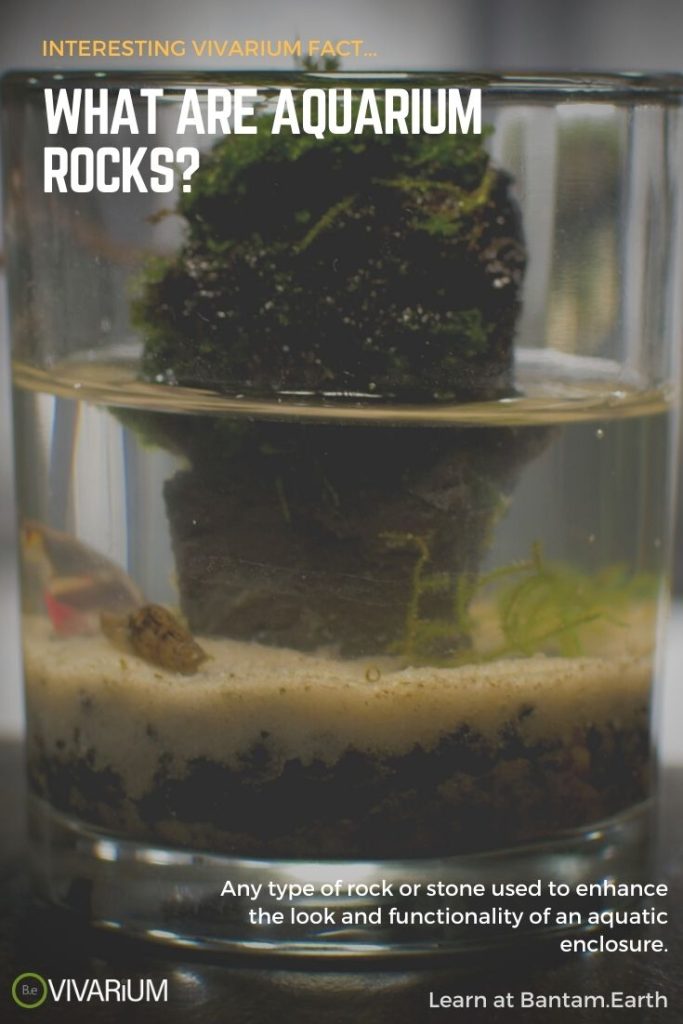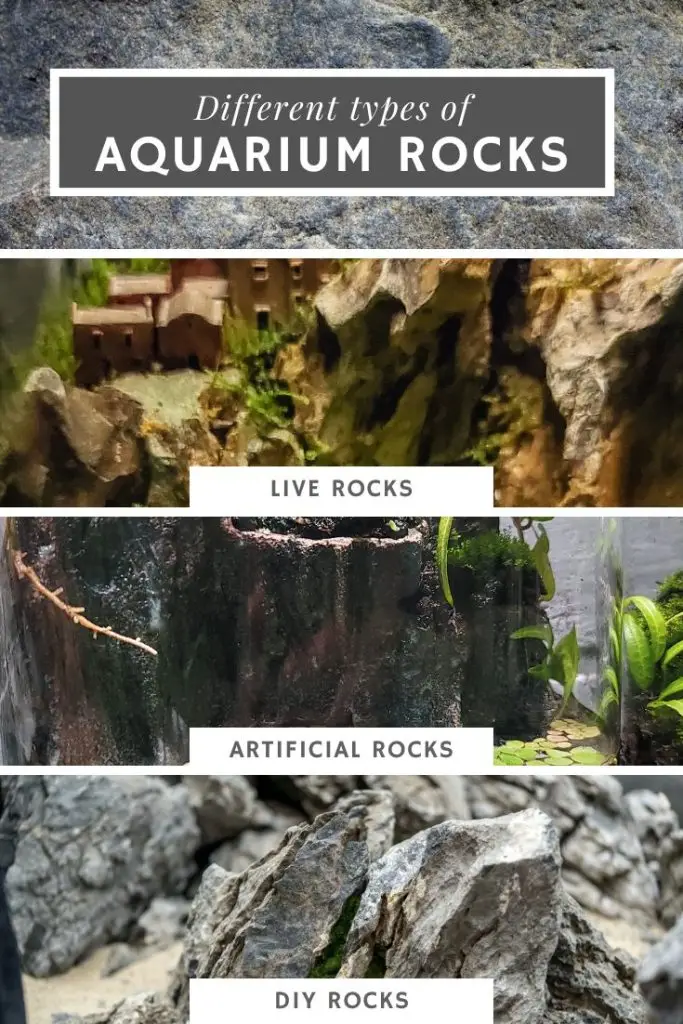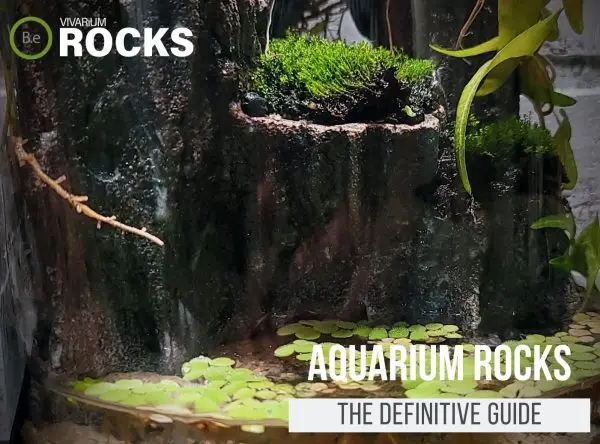Aquarium rocks can take your aquarium to the next level, offering both aesthetics and functional benefits. From live rocks, which provide habitat and support the health of the ecosystem, to decorative rocks which add color and structure to the tank, there are many types and uses of rocks to choose from.
When planning your aquarium, it is essential to consider the types of hardscapes and when to use them, as well as the importance of regular maintenance and cleaning. We’ll explore these topics in more detail to ensure you get the most out of aquascaping rocks and enjoy a healthier aquatic environment.
Table Of Contents:
ToggleWhat Are Aquarium Rocks?
Aquarium rocks, also known as aquascaping rocks, are stones used to enhance the look and function of an aquatic enclosure. They are essential components of any successful fish tank. These rocks come in a variety of forms and types, making them a great addition to any aquarium.


Benefits Of Using Aquarium Rocks
Different types of aquarium rocks can provide a range of benefits to the fish tank, such as providing a habitat for beneficial bacteria, filtering out debris, and providing hiding places for fish. With a wide range of rocks available, aquarium enthusiasts have the option to customize their aquariums as they see fit.
For those who are looking to construct their own habitat, aquarium rocks can be used to create rock formations and features that can provide a natural-looking environment for the fish.
The various types of rock available can help control the pH level of the aquarium water, which can help keep the fish and other inhabitants of the aquarium healthy and happy.
Buying Aquarium Rocks
Sourcing aquarium rocks is made easy with our in-depth vivarium rock guide where we cover a large list of aquascaping rocks and where to find them. It is important to carefully consider the size, shape, and type of rock when buying as each type has its own specific uses.
Fish tank owners should also make sure to regularly clean the rocks to ensure that they don’t become clogged with debris and algae. We will cover proper care more in detail as we go on with this article,
Best Types Of Rocks For An Aquarium
When it comes to choosing the best types of aquarium rocks, there are many options to consider. Live rocks are one popular option for many aquarium hobbyists that offer a natural look as well as an important place for beneficial bacteria to grow.
Decorative rocks come in a variety of shapes, sizes, and colors and can be used to enhance the aesthetic of your tank. For a more custom look and feel, some hobbyists opt to make their own DIY rocks out of clay, foam, or other materials.
Each of these types of stones offers its own benefits and variety, so let’s cover each kind in more detail.
Here is a complete list of vivarium rocks typically used as aquascaping rocks perfect for aquariums.


Aquascaping Live Rocks
Aquascaping with live rocks is a popular way to create a unique and stunning display in your aquarium. Live rocks are real rocks harvested from quarries around the world. they’re an excellent choice for aquascaping
They are an all-natural look that adds color, texture, and contrast. Not only will your tank look amazing, but live rocks also provide a number of important benefits all fish tanks can benefit from.
The Pros
Live rocks provide a rich and unique environment that helps promote the growth of beneficial bacteria. These rocks are also an excellent source of a natural filter, which can remove pollutants, pollutants, and excess debris from your water.
In addition, live rocks provide shelter and habitat for a variety of aquatic life forms. This creates an interesting and visually appealing display and stabilizes water chemistry in an aquarium.
The Cons
Aquascaping with live rocks does come with a few potential downsides. Live rocks are more expensive than some other decorations, and it can also sometimes be difficult to find the right rocks that you need to create the desired effect.
They are easily the heaviest part of an aquascaping setup. If overall weight is something to be mindful of, consider using fake decorative rocks instead.
Basic Care Recommendations
It’s also important to consider the maintenance requirements when aquascaping with live rocks. You might need to regularly clean and monitor your rocks to make sure they are free from algae, parasites, and other pests.
It’s important to measure and regulate the parameters of your water to ensure that the rocks remain in a healthy state. With proper maintenance and care, however, aquascaping with live rocks can create a beautiful aquascape in your tank.
Decorative Rocks For An Aquarium
Decorative artificial rocks are a great way to give your aquarium or aquascape a realistic look. With our artificial rocks, you can create stunning aquascapes with sizes, shapes, and visuals that would be otherwise difficult to achieve with natural rocks.
The advantage of using fake rocks is that they can be molded into unique shapes, providing an ideal foundation to build upon.
The Pros
In terms of benefits, artificial rocks are generally easier to clean, more hygienic, and can more precisely reflect the layout of the aquascape you are attempting to create. Most artificial rocks are lightweight and easy to maneuver, making them convenient and hassle-free to manage.
The Cons
Although artificial rocks may take away some of the beauty and mystery of natural rocks, they can still make for an enjoyable aquascape that can easily be altered or refreshed.
The main drawback of artificial rocks is that their colors could fade over time due to exposure to light, making it important to keep them away from direct sunlight.
Typical Care Requirements
Overall, artificial rocks can be an easy, cost-effective way to create a stunning and unique aquascape. Maintenance with these types of aquarium rocks should be kept to a minimum.
Debris and algae that accumulate on the surface will not only make the rocks look more natural… But it will also make these rocks bioactive like live rocks as beneficial bacteria continue to spread across the surface.
DIY Aquarium Rocks
Aquascaping is an exciting part of aquarium keeping that can really add color and personality. One way to do aquascaping is to make your own DIY rocks!
DIY rocks offer many benefits; they are cost-effective, you can customize their shape and color, and you can always make changes and adjustments whenever you want.
However, DIY rocks also come with potential drawbacks. Crafting your own rocks requires additional time, materials, and sometimes even additional tools.
Plus, some of the materials used in making DIY rocks may not be aquarium-safe, so it’s important to be mindful of this before you begin the project.
How To Work With Aquarium Rocks
When handling rocks of any kind, it is important to remember that each type of rock requires special handling and care. To ensure the health of your aquarium environment, it is essential to know the different types of aquarium rocks… How to identify them… And how to properly use and care for them.
Rock Formations
Designing an aquarium layout with rocks is not only fun but can also be a great source of creative expression. Rocks can be stacked, arranged, and laid out in many different ways to add a unique display to your aquarium.
To get started, a great tip is to select a theme for your aquarium, then look for rocks that have a specific color, texture, and size to create a more uniform look. For example, if you are creating a beach theme, select rocks with light and dark hues, plus different shapes and sizes. This can create a natural-looking beach setting from the comfort of your own home.
In addition to picking the right rocks, placement is key. The depth of your aquarium may play a role in where you place rocks. If the aquarium has a greater depth, choose heavier rocks and make sure they are securely placed. Lighter rocks can create a more whimsical look, often best suited to shallow aquariums.
It is also important to make sure each rock stands out, as too many rocks together can lead to a cluttered and uneven look.
Finally, remember that while the overall look is important, rocks can also serve as a respiratory platform and hiding spot for the fish which inhabit the tank. To encourage healthy water circulation, be sure to leave some space between rocks and allow plenty of areas for the fish to swim.
Doing this will result in a beautiful aquarium layout with plenty of room for the fish to swim and explore.
Regular Maintenance
Regular maintenance of aquarium rocks is essential for keeping your aquarium clean, healthy, and visually appealing. Proper care of aquascaping rocks starts with regular cleanings every few weeks, depending on the size of the tank and the number of rocks.
To clean your rocks, place them in a bucket of tank water and run them through a gravel cleaner or siphon. After cleaning, rinse the rocks off in fresh tap water before placing them back in the tank.
Conclusion
Aquarium rocks can provide the ideal blend of beauty and function. From the natural look of live rocks to the convenience of hardware-based rocks… There is a wide range of options to choose from. With the right design and regular maintenance, rocks can create an inviting and healthy aquatic environment for any variety of fish, plants, and other organisms.
Plus, the myriad of decorative options opens up endless possibilities for creative aquarium layouts and designs. Take the time to explore the many varieties of aquarium rocks… Keep up with routine maintenance, and enjoy the benefit they bring to your aquatic environment.


Frequently Asked Questions
Rocks that are good for freshwater aquariums include lava rocks, slate rocks, and driftwood. For saltwater aquariums, coral rocks and aragonite are the best options. When selecting rocks for any kind of aquarium, be sure to rinse them thoroughly to remove dirt and toxins before adding them to the tank.
It is not recommended to put rocks found outdoors in a fish tank as they can increase the risk of bacterial growth, and can also become a choking hazard for some fish. In addition, certain types of rocks can lead to increased levels of water hardness and can raise pH levels, which can be damaging to fish and aquarium inhabitants.
The best type of rock for a freshwater aquarium is slate. Slate helps to create a natural, appealing environment for freshwater fish, as well as providing beneficial surface areas for beneficial bacteria and other aquarium inhabitants. The list above also provide a number of great rocks just as suitable.
No, aquarium rocks do not have to be boiled prior to using them in an aquarium. Boiling aquarium rocks can be beneficial if you want to increase their porosity and reduce their Ph levels, but it is not required.
To determine if a rock is safe for aquariums, you should always check to make sure it is pH neutral and non–toxic. Additionally, you should inspect the rock for any sharp edges or protrusions that could harm your fish. Furthermore, thoroughly rinse off the rock before placing it in the tank to ensure that it is free of dirt and other debris.
Rocks that are not rounded, such as jagged or sharp-edged rocks, should not be put in an aquarium as these can damage or tear the aquarium liner and harm the fish.
Additionally, rocks that may have been exposed to toxins or chemicals should be avoided as these can harm your fish as well.
Finally, avoid any rocks that may have a high concentration of minerals, such as limestones, that can drastically alter the water parameters of your aquarium.


